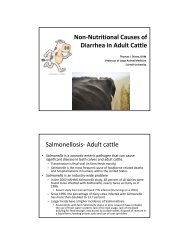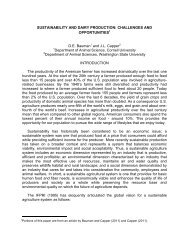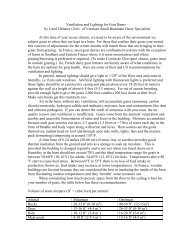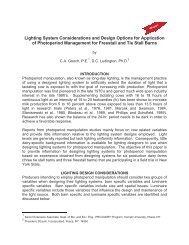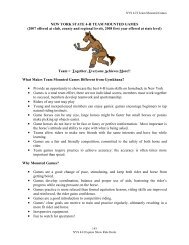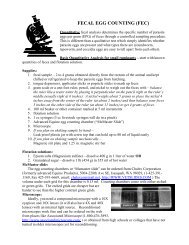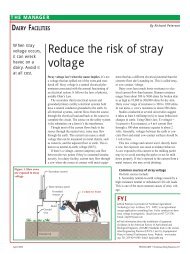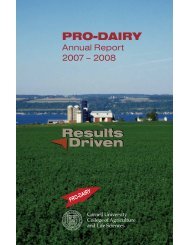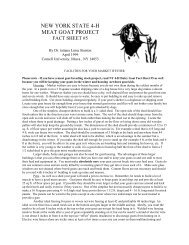1 GOAT SEMEN COLLECTION AND PROCESSING BY DR. LOUIS ...
1 GOAT SEMEN COLLECTION AND PROCESSING BY DR. LOUIS ...
1 GOAT SEMEN COLLECTION AND PROCESSING BY DR. LOUIS ...
Create successful ePaper yourself
Turn your PDF publications into a flip-book with our unique Google optimized e-Paper software.
slide warmer at 37°C. Extended semen was examined directly without dilution, frozen thawed<br />
semen was also examined directly. The slide was then placed on a properly set microscope stage<br />
incubator at about 37°C. The slides were observed under 400x, and at least ten areas of the smear<br />
were used to estimate the percent of motile sperm. All of the slides were estimated to the nearest<br />
five percent for total motility. More abnormal sperm were found near the edge of the slide. This<br />
was most probably due to cold shock and drying out of the preparations.<br />
Processing Semen:<br />
Goats: Immediately after collection, the volume of the ejaculate was recorded and the semen placed<br />
in a water bath at 30°C in order to prevent cold shock. Two sub-samples were taken from the fresh<br />
semen, one to estimate initial motility and the other for the purpose of determining concentration of<br />
the Spectronic 20. From each ejaculate (250 ml of semen - or, if the total volume of the ejaculate<br />
was less than 500 ul) half of the volume was added to each of two 15 ml conical tubes containing 10<br />
ml of Kreb's Ringer Solution at 30°C and mixed by carefully inverting the tubes three times. This<br />
solution was then allowed to cool to room temperature (22-24°C) in a rack for 15 minutes. After this<br />
period of time, the solution was centrifuged for ten minutes and 600-800 g, after which the<br />
supernatant was carefully removed with a pasteur pipette. The packed cells remaining in each<br />
conical tube were re-suspended in six ml of non-glycerated extender at room temperature. Milk-<br />
based extender or egg-tris extender was added to the tubes. After mixing by careful inversion, the<br />
solutions were poured into 25 ml tubes. Each 25 ml tube containing pre-extended semen was<br />
placed into a 250 ml Erlenmeyer flask containing 200 ml of water at room temperature, and placed<br />
in a cold room at 50°C for two hours. The temperature of the water in the flasks, which indicated<br />
the temperature of the pre-extended semen, was checked and recorded every 15 minutes during the<br />
22



